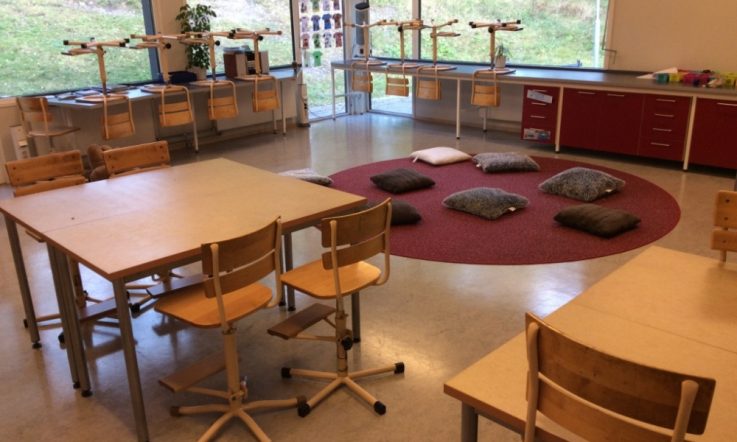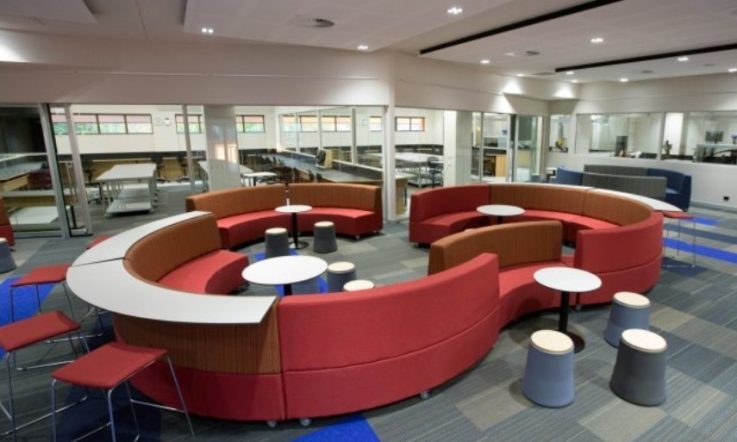- Listen to and download all the Teacher podcasts for free on iTunes and Soundcloud
Hello, you're listening to a podcast from Teacher - I'm Jo Earp. In this month's episode of The Research Files, we talk to Kiri Mealings about a new study involving colleagues at Macquarie University and Australia's National Acoustics Laboratories, into noise levels in open plan classrooms.
JE: Kiri Mealings, welcome to The Research Files.
Kiri Mealings: Thanks for having me, Jo.
JE: The first thing I was interested in was the aim of the research, what were you hoping to get out of it?
KM: The aim of my research was to investigate how the acoustics of different sized open-plan classrooms affect kindergarten children's speech perception. So an open-plan classroom ... they have multiple classes in the same area, and these classes are still divided into spaces of 20 to 30 students with their own teacher, but they're all located in the same room, with no walls separating them. These first came out in the 1960s and '70s with the educational revolution, but they were then closed up because of the noise and visual distractions. However, they've started to appear again in the 21st Century because we're moving again to this more child-centered approach.
So, they provide for a range of activities: they better facilitate group work and social development; they are also seen to help the teachers as they promote the sharing of skills, ideas and experiences; and they allow for team teaching, joint planning and organisation - which is thought to facilitate a more cooperative and supportive atmosphere.
JE: So that's how they're being used, and the aim then was to assess the difference between the open-plan classroom and the closed ones in terms of noise, is that right?
KM: That's right. So we were particular interested in how the noise from the other classes in the area in an open-plan class affects how well children can hear their teacher. We compared this to an enclosed classroom.
JE: Now can you just summarise exactly what you did? [Did this involve] just one school in Sydney?
KM: It was four different classrooms. So we visited four different sized classrooms - we had an enclosed classroom with 25 students, a double classroom with 44 students, a triple classroom with 91 students and then a full primary school classroom that was K-6 and it had about 200 students in the one area.
And our research was split up into three parts ... the first part was the acoustic measures, so we went out into each of these schools and we measured the noise levels while the other classes were doing different activities. We measured the reverberation – so, how much the room echoed. And we looked at the difference between the teacher's voice and the background noise levels. And we compared all of these to the recommended limits for kindergarten classrooms.
The second part of the study, I developed a speech perception task, and we conducted this live in each of the classrooms. This examined how well children could hear words in sentences while the other classes were doing quiet versus noisy activities.
And finally, the third part of the study was questionnaires. So I filled out questionnaires with the children, asking them how they perceived the listening environment in different scenarios, and I also asked the teachers to fill out the questionnaires, asking them how they perceive and teach in the different types of learning environments.
JE: In terms of equipment then, was it just standard equipment to measure decibels and things like that, or was it quite complex?
KM: It was actually quite complex equipment. I took an acoustic engineer out with me, and so we took recordings rather than just using a sound level meter. So we had that, and then we could do offline processing. We also did frequency sweeps, that's how we found the reverberation of the room. So it was quite a big setup. With the acoustic recordings, we were out in the classroom for a day, and then I spent a couple more days doing the surveys, then the speech perception task took another afternoon.
JE: Okay, and obviously from that research then, you've come up with some key findings and conclusions. Can you just take our listeners through, perhaps, some of the highlights of those?
KM: Sure, so we found that the noise levels coming from the other classes in the open-plan classrooms were excessive and well above the recommended limits. When we assessed this objectively in the speech perception task we found that in the enclosed classroom children were achieving around 80 per cent, irrespective of where they were seated in the classroom. However in the noisiest open-plan classroom, while the children at the front were scoring 75 per cent, this dropped right down to 25 per cent at the back. So, this is quite concerning and likely to severely impact these children's learning.
When we talked to the children we found that most of them were annoyed by the noise from other children sharing the area, and 50 to 70 per cent of these children said that they couldn't hear their teacher very well, or at all, when the other classes were doing group work.
And with the teachers' questionnaires: we found that the teachers of open-plan classrooms were more distracted by noise. They found speech communication significantly more difficult, and they experienced [vocal strain problems] more often than the teachers in the enclosed classrooms, due to having to constantly raise their voice above a comfortable level to be heard. So this puts them [at] high risk of having pathological voice problems.
JE: The readings you found in the open-plan classrooms, even during quiet activities, were above recommended noise levels weren't they, and in fact during noisy activities they were over 70 dBA – what does that mean in everyday terms, is there an example you can give?
KM: This is getting close to the noise levels that you would experience if you were standing on a busy street, or if there is a vacuum cleaner in the room. The recommended noise level for classrooms is 50 dBA, so the noise levels shouldn't go above that. We did actually go out twice and do some recordings and we found that they were quite consistent. If anything, the noise levels on the second time were higher, but it is going to depend completely on the classroom. So, classrooms that have more acoustic treatment, or have dividers, then that's going to help bring the noise levels down. So we do really need to look at these classrooms on a case to case basis.

Image © Shutterstock/Christian Mueller
JE: I'm guessing that wasn't too much of a surprise to you, but did you find that the teachers in the schools were quite surprised by what came out of the research?
KM: Yes, so some of them did quite like teaching in the open-plan classrooms, particularly ones that were acoustically treated and so had some division. But, there were other teachers in other classes that were really struggling teaching in that environment, so I think that they were aware that noise was such a problem, but it was just good for them to see a comparison between what the noise levels should be, what they were, and what the impact of this is.
JE: So, then another important step in this research is the implications, I'd guess. What does your work mean for educators in schools, policy makers even? But, particularly those on the ground at a very practical level?
KM: Due to the adverse affects on the students and teachers, our findings suggest that open-plan classrooms that are unable to control the noise from adjacent classes are unlikely to be suitable learning environments for young children. Acoustically treated, enclosed classrooms, are much better listening environments.
However, we understand that because of the changing teaching methods and the use of technology in the classroom that open-plan classrooms may still be desired. So we suggest that, if they are, then they need to be purpose-built as flexible learning spaces. They need to have proper acoustic treatment and, most importantly, operable walls that can be closed when a class is engaged in critical listening activities. They also need to have quiet rooms, as these are essential for children who have particular difficulty listening in noise - so they can go into these rooms and work quietly away from the other students when needed.
Also, it's really important that teachers are trained how to teach effectively in these open-plan classrooms, because that's [going to] look different to when they are teaching in a traditional, enclosed classroom. So when they need to have a more enclosed space to teach, coordinating activities between the classes, so that all classes are doing quiet activities at the one time – so we don't have one class that is trying to listen to their teacher while another class is doing really noisy activities – so all of that sort of stuff.
JE: Now the next steps then, in terms of the research in this area, are you working on a follow up study? Where should we be looking to take this now that these findings are out?
KM: Yeah, so we'd really love to continue researching this area ... our study mainly looked at speech perception, but it would be interesting to look at other areas of learning. The literature does say that high noise levels affect children's literacy, and numeracy, and reading development, but it would be interesting to look at some other areas, just to see if there are some benefits to this collaborative learning. And so then maybe open-plan classrooms can be used for that, but then we can go back to these closed off spaces for where critical listening is essential.
We'd also really like to look at how children with special educational needs cope in open-plan classrooms. So this includes children with attention deficits, hearing impairments, language delays and English as a Second Language, because these children are more commonly integrated into mainstream classes now, so it is likely that we will find these [children] in open-plan classrooms.
We'd also really like to do a large-scale study looking at lots of different types of open-plan classrooms to see what's working [and] what's not working. So this [could be] with acoustic treatments, how it's designed, the number of classes and students [that] should be in an area, and we also need to look at the age of the children, because children are going to be able to cope with noise differently when they get older. So it's really important this research is conducted so that we can design open-plan classrooms that meet the recommended noise levels to ensure adequate speech perception in the learning environment.
JE: That's been really interesting Kiri. Thanks ever so much. Good luck with the next stage of the research and thanks for speaking to The Research Files.
KM: Thanks Jo.
For more information on the research discussed in this podcast and to access other articles and videos - visit www.teachermagazine.com.au, or join our community on social media via Facebook and Twitter.
Access the research report related to this podcast: An investigation into the acoustics of an open plan compared to enclosed Kindergarten classroom
- Make sure you don't miss a Teacher podcast, subscribe for free by visiting acer.ac/teacheritunes or www.soundcloud.com/teacher-ACER.
Do you have an open-plan classroom in your school - is it a flexible space that can be closed off during particularly noisy activities?
When working in an open-plan classroom, do you coordinate activities with other teachers?
As a teacher, whatever learning space you're in, can all students hear what you are saying? How do you know?



